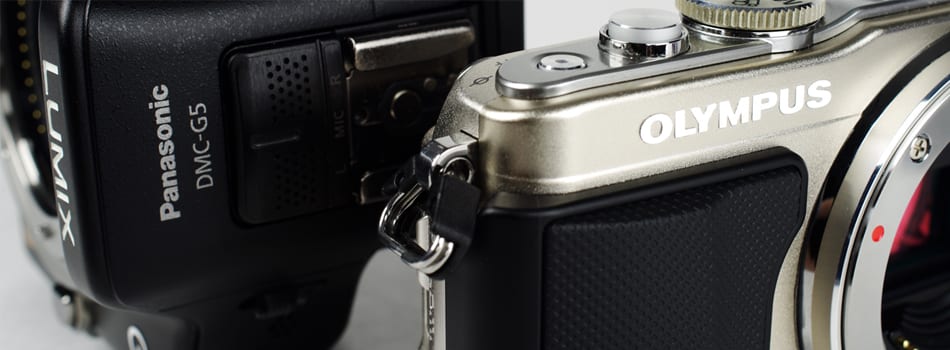Head to Head: Panasonic Lumix G5 vs. Olympus PEN E-PL5
Olympus and Panasonic are the Jets and Sharks of Micro Four Thirds. It's time for a compact system rumble!
 Credit:
Credit:
Products are chosen independently by our editors. Purchases made through our links may earn us a commission.
Introduction
The two companies that represent the Micro Four Thirds standard, Olympus and Panasonic, share similar technology, but very different takes on industrial design. Olympus is representin’ retro while Panasonic's cameras have a distinctly modern style. Recently, we got our hands on the midrange model from each company's lineup, the Panasonic Lumix G5 and the Olympus PEN E-PL5. The two models couldn't look more different, but their divergent designs only hint at how different these cameras are. Both live in the same price bracket, but they have strengths and weaknesses all their own.
Handling & Portability
Although the E-PL5 isn't a tiny camera (Pentax's diminutive Q10 still holds the title of smallest interchangeable lens camera), the G5 does make it seem much more compact by comparison. Whereas the E-PL5 does away with bulk and has a streamlined body, the G5 isn’t ashamed to be a full-bodied camera. With a big, chunky grip for your right hand, the Panasonic feels like a small DSLR. By design, that means there's extra space for more custom buttons and additional controls that we found to be useful. The E-PL5's software tries to compensate for the lack of customizable controls, but it still can't replace the real thing.

But, for the G5, a DSLR-style body doesn't necessarily translate into DSLR-style build quality. Although we didn't love the E-PL5's wimpy grip, the plasticky, hollow-feeling G5 definitely makes it seem much nicer by comparison. The G5's ergonomics are better than the smaller, less contoured E-PL5, but, we've got to say that there's a noticeable gap in material quality between the two cameras. While neither of them impressed us with their tactile assets (buttons and dials), the Olympus feels solid where the G5 feels chintzy.
People who prefer composing with a viewfinder will probably gravitate towards the G5, since it has one built-in. The E-PL5 is more limited because it relies on an accessory port to plug in an optional viewfinder (which is not included). Furthermore, the E-PL5's hot shoe will be monopolized by the viewfinder whereas the G5 happily can use an accessory on the hot shoe while looking through the viewfinder. With the E-PL5, you can use the included flash, an optional EVF, or any other hot shoe accessory, but they're mutually exclusive. Depending on how you plan on using your camera, the inflexibility of the Olympus’s system may swing your decision the other way.
Between its bigger body and its longer, larger kit lens, the G5 is indisputably the less portable of these two cameras. The kit lenses we tested on the E-PL5 and the G5 were both 14-42mm, f/3.5-5.6, but the Panasonic's lens doesn't collapse, whereas the Olympus lens does. To some, this will be a good thing— having to unlock the E-PL5's kit lens before using it and putting it away takes getting used to. Because the G5's lens is ready to shoot immediately, some might see that as a usability win, but at the expense of portability.
Features
When we reviewed the E-PL5, we faulted it for its complex software; the menus aren't straightforward in the slightest, and the most useful menus are deactivated by default. That said, users who take the time to learn how to use this camera are rewarded mightily. The E-PL5 has a great array of features and options that are user-selectable. But, the steep learning curve might send some curious amateur photographers screaming in the other direction.

The G5, on the other hand, has very straightforward menus. Panasonic's menu system is very similar to what we’ve seen on their camcorders—everything is clearly labeled and nothing is too far out of the way. The Quick Menu button allows access to most of the normal manual features very quickly and painlessly. The Olympus takes some coaxing—the E-PL5’s excellent Super Control Panel isn't made accessible by default, and is hard to find. Olympus has a similar setup with their Super Control Panel, but you have to dig through several menus just to find the option for it.
On paper, these two cameras stand shoulder-to-shoulder on features. In reality, the E-PL5 outdoes the G5 both in quality and quantity of features, including a blazingly fast (nearly 8 fps) burst mode and customizable self-timer functions. The E-PL5 also has more ISO choices available, more responsive touch-to-shoot and touch-to-focus controls and we liked its art filters better. Buyers should note that the G5 doesn’t have image stabilization in the body, instead relying on lenses with it built-in. The E-PL5, like its Olympus brethren, has in-body IS, which means even a manual SLR lens hooked on with an adapter can benefit from it.
The G5 triumphs on the video side of the wall, providing more frame rates (the E-PL5 only shoots 1080/30p, whereas the G5 can muster 1080/60p) and better low light response (in our low light sensitivity test, the G5 needed only 10 lux to make it to 50 IRE whereas the E-PL5 required 17.5 lux). Neither camera has a 24p frame rate or an external mic jack, making both less than ideal for filmmaking.
Image Quality
Both cameras offer up 16 megapixels of interchangable lens goodness, but the E-PL5's measurable image quality was superior to the G5's in our lab. Anecdotally, we preferred the look and quality of images produced by the Olympus camera. The E-PL5 sports the same processor and sensor combo as Olympus’s higher-end E-M5 OM-D and it shows. Even when comparing the E-PL5 directly to the OM-D, we found that the cheaper camera punched above its weight and provided an excellent bang-to-buck ratio. The G5 is saddled with an older sensor (rumored to be a version of the sensor found in Panasonic's 2011 Lumix GH2) and it’s starting to show its age.
In our lab, we found that the G5 scored lower than the E-PL5 in our resolution and sharpness tests. We were pleased to see that the G5 didn’t oversharpen too much, but when it came down to doing a resolution test, the G5 fell flat on its face. At first, we thought it might have something to do with the different kit lenses included with each camera. But, since these are both interchangeable lens bodies in the same system, we did a back-to-back test with the excellent Panasonic Leica Summilux 25mm f/1.4 lens. Even with this great piece of glass on it (and dialed in to its overall sharpest f-stop), the G5 failed to deliver results as good as the E-PL5. Some of this discrepancy might be due to the G5’s anti aliasing filter, a feature that the E-PL5 does without. Cameras without AA (also known as optical low-pass) filters are able to produce sharper images generally speaking.
The E-PL5 trounced the G5 in our white balance test. In our auto and custom white balance tests, the E-PL5 proved itself to be very adept across incandescent, fluorescent, and daylight settings, accurately depicting accurate color in each scene. Both cameras have the same number of presets for white balance, and both enable the user to enter in color temperature manually.
Conclusion
It's an excellent time to be shopping for a compact system camera, and the G5 as well as the E-PL5 are good examples of the diversity of the Micro Four Thirds system. The two cameras might seem similar when looking at the specs but, as we found both in the lab and in the field, the G5 is the inferior camera in most aspects.
Although it debuted at the steep, steep price of $699.99, the G5 is available for around $500 at this point in time. The E-PL5's MSRP was $649.99 when we reviewed it, but that price has also dropped to around $600. Both can be had for a bit less body-only if you're already in the M43 ecosystem and don't need a kit lens.
With its more advanced sensor, higher quality materials, exceptional image quality and well-implemented features, the Olympus E-PL5 is still the champion of this segment. In spite of its quirks, the E-PL5 is a camera that you'll appreciate more the longer you use it. Seeing how the E-PL5 and G5 are only roughly $100 apart right now, that’s money that translates directly into better performance.
